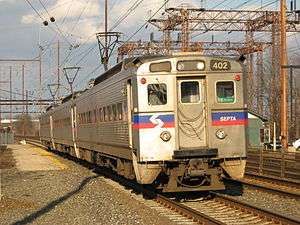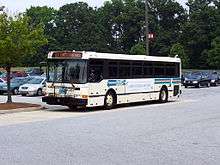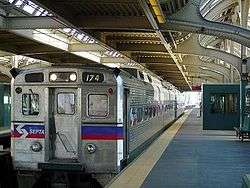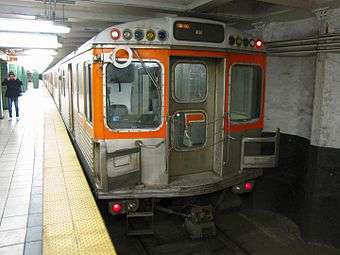Trenton Line (SEPTA)
| Trenton Line | |
|---|---|
|
Train #4656 pulls into the Cornwells Heights station. | |
| Overview | |
| Type | Commuter rail line |
| System | SEPTA Regional Rail |
| Status | Operating |
| Termini |
Trenton Temple University |
| Daily ridership | 12,263[1]:94 |
| Website | septa.org |
| Operation | |
| Operator(s) | SEPTA |
| Technical | |
| Track gauge | 4 ft 8 1⁄2 in (1,435 mm) standard gauge |
| Electrification | Catenary |
The Trenton Line is a route of the SEPTA Regional Rail (commuter rail) system. The route serves the northeastern suburbs of Philadelphia, Pennsylvania with service in Bucks County along the Delaware River to Trenton, New Jersey.
Route
Trenton Line trains make local stops along Amtrak's Northeast Corridor between Philadelphia and Trenton, NJ. The section of Northeast Corridor the Trenton Line uses is a 4-track railroad, from 30th Street Station via the Philadelphia Zoo (without stopping there), to North Philadelphia, before running parallel to I-95 and then US 13 for several miles. It crosses the Delaware River at Trenton, New Jersey before making its final stop at Trenton Transit Center, which is also served by Amtrak and New Jersey Transit trains.
History
Electrified service between Philadelphia and Trenton began on June 29, 1930.
Between 1984–2010 the route was designated R7 Trenton as part of SEPTA's diametrical reorganization of its lines. Trenton Line trains operated through the city center to the Chestnut Hill East Line on the ex-Reading side of the system.[2]The R-number naming system was dropped on July 25, 2010.[3]
The Trenton line usually has two push-pull electric-locomotive-hauled trains on the morning express runs and two on the evening express runs. Each train is usually made up of 6 coach trailers made by Bombardier with AEM-7 or ALP-44 locomotives hauling them.
Stations
The Trenton Line includes the following stations north of the Center City Commuter Connection; stations indicated with italics are closed. Weekday boardings are from FY 2013; data for North Philadelphia includes Chestnut Hill West Line boardings. All stations are located within Philadelphia.[1]:95–96
| Zone | Distance | Station | Boardings | City/Township | County | Connections |
|---|---|---|---|---|---|---|
| C | 1.9 | Zoological Garden | 0 | Philadelphia | ||
| 2.8 | Engleside[note 1] | |||||
| 3.2 | Ridge Avenue[note 1] | |||||
| 3.9 | 22nd Street[note 2] | |||||
| 1 | 4.5 | North Philadelphia | 184 | |||
| 11th Street | ||||||
| North Penn Junction | ||||||
| Harrowgate | ||||||
| Frankford Junction | ||||||
| Frankford | ||||||
| 2 | 9.3 | Bridesburg | 209 | |||
| Fitler | ||||||
| 10.1 | Wissinoming | |||||
| 11.2 | Tacony | 208 | ||||
| 12.2 | Holmesburg Junction | 515 | ||||
| 3 | Liddonfield | |||||
| Pierson's Station | ||||||
| 14.8 | Torresdale | 1,095 | ||||
| Andalusia[note 3] | Bensalem Township | Bucks County | ||||
| 16.9 | Cornwells Heights | 1,657 | ||||
| 18.2 | Eddington | 45 | ||||
| 19.9 | Croydon | 393 | Bristol Township | |||
| 4 | 22.7 | Bristol | 360 | Bristol | ||
| Edgely | Bristol Township | |||||
| 26.0 | Levittown | 624 | Tullytown | |||
| Tullytown[note 4] | ||||||
| Morrisville[note 5] | Morrisville | |||||
| NJ | 32.5 | Trenton | 1,251 | Trenton, New Jersey | Mercer County | |
Ridership
Between FY 2008–FY 2014 yearly ridership on the Trenton Line has ranged from 3.1–3.5 million.[1]:94[4][5][6][7][8][9]
Notes
- 1 2 Abandoned April 5, 1903, due to competition from trolley companies
- ↑ Abandoned; not to be confused with the Allegheny station on the Manayunk/Norristown Line which was formerly called 22nd Street.
- ↑ Station closed in 1991
- ↑ Closed and replaced 1953 by adjacent Levittown station
- ↑ Station closed 1969
References
- 1 2 3 "Fiscal Year 2016 Annual Service Plan" (PDF). SEPTA. June 2015. Retrieved August 13, 2016.
- ↑ Vuchic, Vukan; Kikuchi, Shinya (1984). General Operations Plan for the SEPTA Regional High Speed System. Philadelphia: SEPTA. pp. 2–8.
- ↑ Lustig, David (November 2010). "SEPTA makeover". Trains Magazine. Kalmbach Publishing: 26.
- ↑ "Fiscal Year 2015 Annual Service Plan" (PDF). SEPTA. May 2014. p. 60. Retrieved August 13, 2016.
- ↑ "Fiscal Year 2014 Annual Service Plan" (PDF). SEPTA. May 2013. p. 44. Retrieved August 13, 2016.
- ↑ "Fiscal Year 2013 Annual Service Plan" (PDF). SEPTA. May 2012. p. 55. Retrieved August 13, 2016.
- ↑ "Fiscal Year 2012 Annual Service Plan" (PDF). SEPTA. July 2011. p. 94. Retrieved August 13, 2016.
- ↑ "Fiscal Year 2011 Annual Service Plan" (PDF). SEPTA. June 2010. p. 70. Retrieved August 13, 2016.
- ↑ "FY 2010 Annual Service Plan" (PDF). SEPTA. June 2009. p. 63. Retrieved August 13, 2016.







